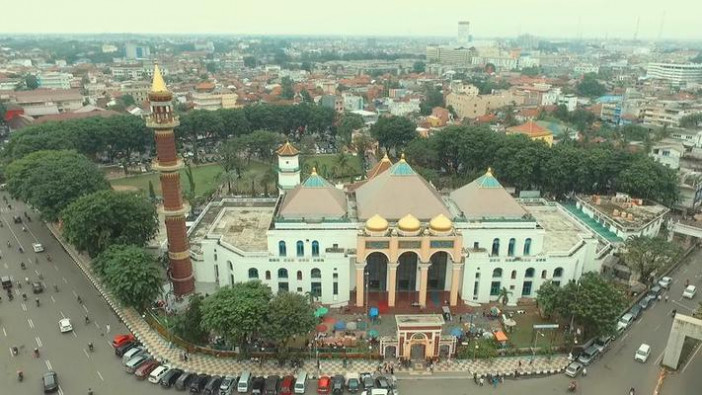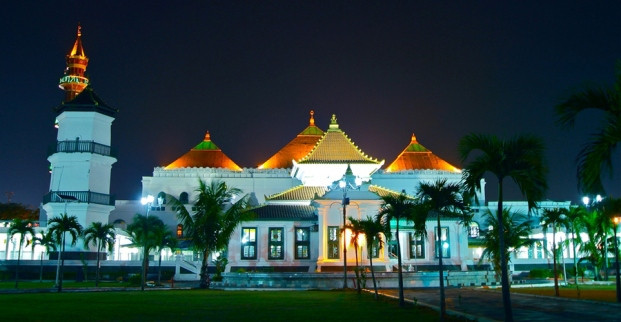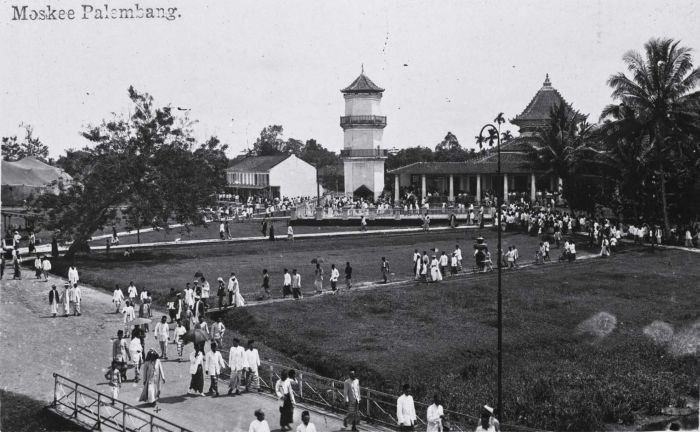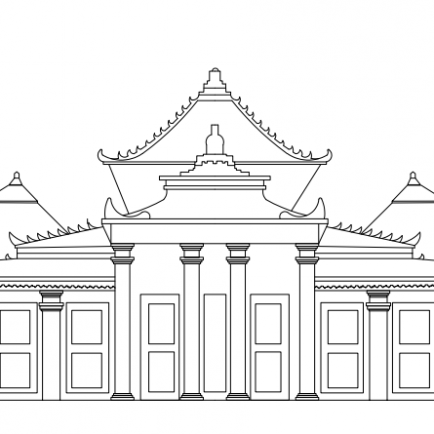Palembang Grand Mosque
History
When there was a war between the Palembang people and the Dutch in 1659 AD, a mosque burned down. The mosque is a mosque built by the Sultan of Palembang at that time, Ki Gede Ing Suro , which is located in the Kuto Gawang Palace . A few years later, in 1738 AD to be precise, Sultan Mahmud Badaruddin I Jayo Wikramo rebuilt the mosque right where the burning mosque was.
The construction of the new mosque took a long time, until on May 26 1748 or 28 Jumadil Awal 1151 Hijri year, the mosque was only inaugurated. At the beginning of its construction, Palembang people called the Great Mosque of Palembang by the name Sulton Mosque. The name refers to the construction of the mosque which is chaired and managed directly by Sultan Mahmud Badaruddin I Jayo Wikramo.
When it was first built, the mosque covered an area of 1,080 square meters (about 0.26 hectares) with a capacity of 1,200 people. The land was then expanded by Sayid Umar bin Muhammad Assegaf Altoha and Sayid Achmad bin Syech Sahab under the leadership of Prince Nataagama Karta Mangala Mustafa Ibnu Raden Kamaluddin.
Initially this mosque did not have a minaret. During the reign of Sultan Ahmad Najamudin (reign 1758–1774) a minaret was built. The location of the minaret is separate from the main building, and is in the west. The minaret pattern of the mosque is a hexagon as high as 20 meters. The shape of the mosque tower resembles a temple tower. The shape of the tower roof is curved at the ends, and is roofed with tiles. The minaret has a fenced terrace surrounding the minaret building.
Palembang Grand Mosque as one of the oldest mosques in the archipelago has undergone various renovations.
From 1819-1821, renovations were carried out by the Dutch colonial government . After that, further expansions took place in 1893, 1916, 1950, 1970, and finally in the 1990s. During the expansion in 1966-1969 by the Great Mosque Foundation, the second floor was built with a land area of 5,520 square meters with a capacity of 7,750 people. On 22 January 1970 construction of a new tower sponsored by Pertamina began . The new minaret, 45 meters high, accompanying the original Chinese-style minaret, was inaugurated on 1 February 1971. The mosque is very distinctive with its Palembang Malay tradition. Most of the wood in the mosque's architecture has a typical Palembang Malay carving called Lekeur.
One of the biggest renovations occurred in 1999. The renovations carried out by Governor Rear Admiral H Rosihan Arsyad not only repaired the damaged parts, but also restored the mosque building by adding three new buildings. The three buildings include buildings in the south of the mosque, in the north, and in the east. In this renovation and restoration, the dome of the mosque also underwent repairs on various sides.
Currently, the original building of this mosque is located in the middle of the new building, inaugurated by the fifth President of Indonesia , Megawati Soekarnoputri.
Urban and Architectural
This mosque is influenced by 3 architectures namely Malay , Chinese and European. The typical style of Nusantara architecture is the pattern of the three-tiered main building structure with the top shaped like a limas. The third tier which is the top of the mosque or mustaka has steps carved with tropical flowers. At the end of the mustaka there is a mustaka with a cracked flower pattern. The shape of the steps of the mosque building was influenced by the basic building of the Hindu-Javanese temple, which was later absorbed by the Great Mosque of Demak. A characteristic feature of European architecture is found in the appearance of large and tall mosque windows. The pillars of the mosque are large and give a solid impression. Building materials such as marble and glass are imported directly from Europe. While Chinese architecture is seen from the main mosque with a limas-shaped roof, consisting of three floors. On the upper side of the roof ridge there is a fringe of simbar leaves resembling a curved goat's horn. Each side of the limas has 13 jurai. The shape of the jurai is curved and sharp. This form is the shape of the rooftemple . [2] This mosque used to be the largest mosque in Indonesia for several years. [3] The mosque's current form is the result of a renovation in 2000 and was completed in 2003. Megawati Soekarnoputri was the one who inaugurated this giant modern South Sumatran mosque.
Description
Palembang Grand Mosque Or The Great Mosque of Sultan Mahmud Badaruddin I Jayo Wikramo is the largest mosque in the city of Palembang , South Sumatra . This mosque was founded in the 18th century by Sultan Mahmud Badaruddin I Jayo Wikramo . Currently, the Great Mosque of Palembang has become a regional Mosque in the ASEAN region . This mosque occupies a complex of 15,400 square meters, in area 19 Ilir, where it is one of Palembang's original Malay and Arab villages that have been inhabited for a long time.
Details
Location
Jl. Jend. Sudirman, 19 Ilir, Kec. Bukit Kecil, Kota Palembang, Sumatera Selatan 30111, Indonesia
Worshippers
15000
Owners
Indonesian Mosque Council
Architect Name
Year of Build
1738
Area
15400
Drawings
Map
History
When there was a war between the Palembang people and the Dutch in 1659 AD, a mosque burned down. The mosque is a mosque built by the Sultan of Palembang at that time, Ki Gede Ing Suro , which is located in the Kuto Gawang Palace . A few years later, in 1738 AD to be precise, Sultan Mahmud Badaruddin I Jayo Wikramo rebuilt the mosque right where the burning mosque was.
The construction of the new mosque took a long time, until on May 26 1748 or 28 Jumadil Awal 1151 Hijri year, the mosque was only inaugurated. At the beginning of its construction, Palembang people called the Great Mosque of Palembang by the name Sulton Mosque. The name refers to the construction of the mosque which is chaired and managed directly by Sultan Mahmud Badaruddin I Jayo Wikramo.
When it was first built, the mosque covered an area of 1,080 square meters (about 0.26 hectares) with a capacity of 1,200 people. The land was then expanded by Sayid Umar bin Muhammad Assegaf Altoha and Sayid Achmad bin Syech Sahab under the leadership of Prince Nataagama Karta Mangala Mustafa Ibnu Raden Kamaluddin.
Initially this mosque did not have a minaret. During the reign of Sultan Ahmad Najamudin (reign 1758–1774) a minaret was built. The location of the minaret is separate from the main building, and is in the west. The minaret pattern of the mosque is a hexagon as high as 20 meters. The shape of the mosque tower resembles a temple tower. The shape of the tower roof is curved at the ends, and is roofed with tiles. The minaret has a fenced terrace surrounding the minaret building.
Palembang Grand Mosque as one of the oldest mosques in the archipelago has undergone various renovations.
From 1819-1821, renovations were carried out by the Dutch colonial government . After that, further expansions took place in 1893, 1916, 1950, 1970, and finally in the 1990s. During the expansion in 1966-1969 by the Great Mosque Foundation, the second floor was built with a land area of 5,520 square meters with a capacity of 7,750 people. On 22 January 1970 construction of a new tower sponsored by Pertamina began . The new minaret, 45 meters high, accompanying the original Chinese-style minaret, was inaugurated on 1 February 1971. The mosque is very distinctive with its Palembang Malay tradition. Most of the wood in the mosque's architecture has a typical Palembang Malay carving called Lekeur.
One of the biggest renovations occurred in 1999. The renovations carried out by Governor Rear Admiral H Rosihan Arsyad not only repaired the damaged parts, but also restored the mosque building by adding three new buildings. The three buildings include buildings in the south of the mosque, in the north, and in the east. In this renovation and restoration, the dome of the mosque also underwent repairs on various sides.
Currently, the original building of this mosque is located in the middle of the new building, inaugurated by the fifth President of Indonesia , Megawati Soekarnoputri.
Urban and Architectural
This mosque is influenced by 3 architectures namely Malay , Chinese and European. The typical style of Nusantara architecture is the pattern of the three-tiered main building structure with the top shaped like a limas. The third tier which is the top of the mosque or mustaka has steps carved with tropical flowers. At the end of the mustaka there is a mustaka with a cracked flower pattern. The shape of the steps of the mosque building was influenced by the basic building of the Hindu-Javanese temple, which was later absorbed by the Great Mosque of Demak. A characteristic feature of European architecture is found in the appearance of large and tall mosque windows. The pillars of the mosque are large and give a solid impression. Building materials such as marble and glass are imported directly from Europe. While Chinese architecture is seen from the main mosque with a limas-shaped roof, consisting of three floors. On the upper side of the roof ridge there is a fringe of simbar leaves resembling a curved goat's horn. Each side of the limas has 13 jurai. The shape of the jurai is curved and sharp. This form is the shape of the rooftemple . [2] This mosque used to be the largest mosque in Indonesia for several years. [3] The mosque's current form is the result of a renovation in 2000 and was completed in 2003. Megawati Soekarnoputri was the one who inaugurated this giant modern South Sumatran mosque.
Description
Palembang Grand Mosque Or The Great Mosque of Sultan Mahmud Badaruddin I Jayo Wikramo is the largest mosque in the city of Palembang , South Sumatra . This mosque was founded in the 18th century by Sultan Mahmud Badaruddin I Jayo Wikramo . Currently, the Great Mosque of Palembang has become a regional Mosque in the ASEAN region . This mosque occupies a complex of 15,400 square meters, in area 19 Ilir, where it is one of Palembang's original Malay and Arab villages that have been inhabited for a long time.








